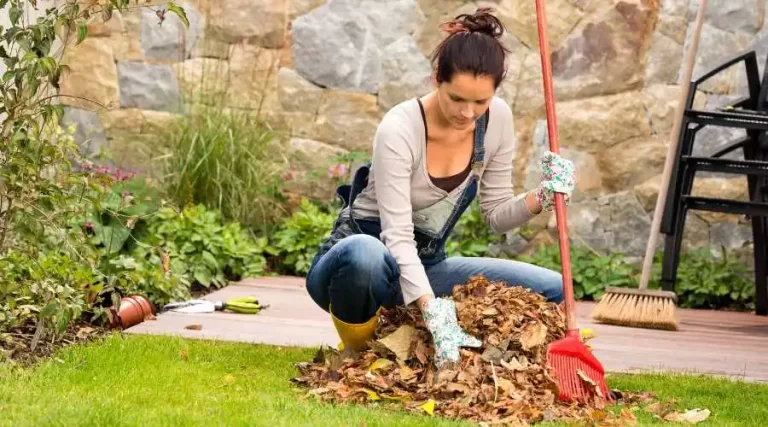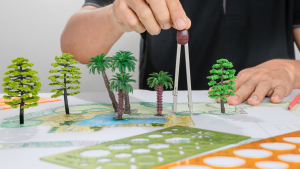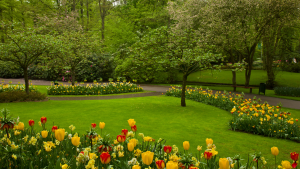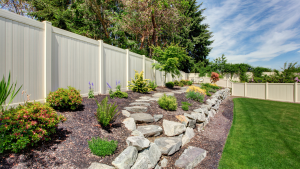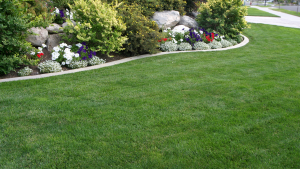As summer’s heat starts to fade and temperatures cool, your lawn and garden demand your care and consideration. These seven fall landscaping maintenance are vital for the well-being and neatness of your property, so carve out some time and commence your outdoor endeavors this autumn. Reach out to ZDR Baton Rouge Landscape Pros if you need any help along the way.
1 – Start a Fresh Lawn
Autumn presents an excellent opportunity to sow new grass seed and cultivate a fresh, vibrant lawn from the ground up. While sod may offer convenience, it often comes with a hefty price tag. Grass seeding is an affordable method of establish a lawn, provided you’re willing to nurture the area until it’s robust.
It’s essential to keep foot traffic off the freshly seeded area and maintain a consistent, gentle watering regimen. The milder temperatures during this season are ideal for seeding, having bid farewell to the scorching summer heat but not yet facing the freezing cold of winter. Fall’s inherent moisture creates a conducive environment for seed growth, offering the ideal conditions for your lawn to flourish.
Whether you’re a new homeowner or revitalizing a patchy portion of your existing yard, autumn is the opportune moment to lay the foundation for a resilient, lush lawn that you can relish in the coming year.
2 – Bring On the Bulbs
Spring bulbs, such as tulips, dandelions, and crocuses, bring a burst of color to the early days of the gardening season. To ensure robust and vibrant blooms in the following season, it’s important to put in the groundwork during September, October, and November.
When planting these bulbs, dig to the specified depth, making sure to place them with their roots facing downward. It’s advisable to plant them in groups of three, six, or nine, as larger clusters of flowers create a more striking visual impact compared to solitary blooms. Coordinating colors is also key because spring bulbs shine brightly in the otherwise drab early season landscape.
In your bulb selection, don’t overlook unique varieties in addition to the well-loved favorites. For instance, snowdrops can be an excellent groundcover choice, while any member of the narcissus family will make for a captivating start to the spring season. The effort you put into planting these bulbs in the fall will reward you with a vibrant and picturesque garden come springtime.
3 – Clean Up the Garden
It’s time to get your garden ready for fall its winter slumber. This involves tidying up overgrown perennials and ensuring that any diseased foliage and flowers are removed. However, it’s crucial to completely discard organic matter containing disease, as putting it in your compost pile can spread the problem further.
There are two distinct approaches to fall garden clean-up, each with its own merits. Some gardeners opt for an extensive trim, removing flowers, seeds, and berries, which results in a clean slate for the spring. However, this approach may deprive local wildlife of a valuable food source during the winter.
On the other hand, some gardeners choose to leave their garden mostly intact in the fall to provide sustenance for birds and small animals. The snow covering this growth helps expedite the composting process, enriching the soil in the long run. It’s worth noting that this approach necessitates more thorough clean-up in the spring. Many gardeners believe that the ecological benefits outweigh the extra work in the end. The decision between the two approaches ultimately comes down to your priorities and the local wildlife in your area.
4 – Weed Out the Weeds
Regardless of your approach to garden clean-up, it’s essential to tackle weeds. Remove them at the root to prevent their return in the spring. Weeds in your lawn should also be dealt with using your preferred method.
When it comes to weeds, it’s crucial to ensure that they are completely eliminated. Burning or discarding them is a better choice than composting, as composting weed seeds can lead to future problems. Additionally, many municipal composting facilities may not accept weeds, so proper disposal is essential to prevent the spread of weeds and preserve the health of your garden.
5 – Prep the Vegetable Patch for Next Year
When it’s time to harvest the last of your tomatoes, gourds, corn, and pumpkins, it’s important to think about how you’re leaving your vegetable patch. Begin by removing any diseased or spent foliage. Many farmers simply turn over the soil and mix in leftover produce, which can improve the overall soil quality. But this approach may be a little difficult. for residential gardeners.
If you lack the equipment for soil turnover or follow the rotation method of organic pest control (not planting the same vegetables in the same spot the following year), leaving leftover produce to decompose can result in unexpected volunteer plants. If this isn’t part of your plan, it’s advisable to clean out the garden, then turn over the soil while incorporating peat moss or clean compost. This helps maintain a healthy and weed-free garden bed for the following growing season.
6 – Tree Planting Season
Planting trees in the fall is a strategy that often goes overlooked, but it can be highly advantageous. The moderate temperatures and moist soil create ideal conditions for many tree species to establish their roots. Additionally, autumn often sees garden centers offering discounts on their stock, making it an opportune time to secure some excellent deals.
When planting trees in the fall, ensure that they are beyond the delicate, vulnerable stage and follow the planting instructions carefully. You may need to provide some extra care, such as feeding the newly planted trees or using a transplanting solution for a few weeks to aid their establishment. Some trees come with burlap-wrapped roots, which are relatively easy to plant, and certain species are available in biodegradable pots, simplifying the planting process. Fall tree planting can set the stage for healthy and robust growth in the coming seasons.
7 – Protect the Tender Ones
Protecting tender trees, shrubs, and bushes is crucial to ensure their survival during the upcoming winter season. This is particularly important for species like Japanese Maples and certain Hydrangeas. Depending on your gardening zone and your garden’s exposure, some perennials may also require protection.
For tall bushes and small trees, consider cover them with burlap to protect them from the hard winter weather. Ensure that the burlap is securely staked to prevent it from being caught and damaging the plant during heavy winds. Low-lying plants and shrubs that rely on new spring growth for blooming can be safeguarded by mounding soil around their base. This helps maintain warmth and sets the stage for a beautiful display in the next spring.
Indeed, fall encompasses more than just leaf raking. There are several essential fall landscaping tasks that contribute to a tidy property during the winter. From planting new grass seed, trees, and spring bulbs to weeding and safeguarding your cherished plants, these tasks not only promote a healthier landscape but also reduce the work required in the springtime.

